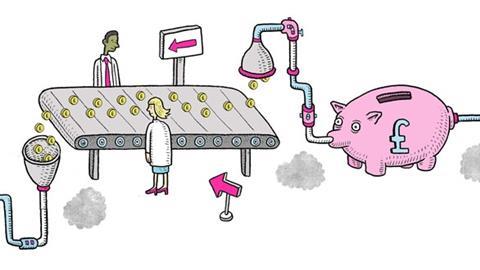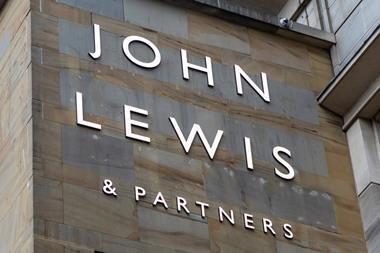The recession has done nothing for retailers’ relationships with their suppliers, as both sides struggle to manage cash flow. Liz Morrell explains how supply chain finance can aid working capital for both

With cash flow critical, logic dictates that retailers and suppliers should be taking advantage of the benefits of supply chain finance. Yet only a handful of retailers have adopted this way of working in order to benefit from the improved cash flow and enhanced supplier relationships that it can bring about.
Supply chain finance helps bridge that ever-contentious point between retailer and supplier - in other words, the supplier’s desire to be paid quickly versus the retailer’s desire to extend credit terms. Both sides’ demands have become even more exaggerated in the recession as cash flow management has become more important.
It works by the supplier selling its invoices to the bank at a rate discounted against the credit rating of the retailer. The bank then pays the supplier when the supplier wants payment, and the retailer pays the bank in line with normal payment terms.
Supply chain finance benefits
For the retailer
- Reduced cost,working capital and risk in the supply chain
For the supplier
- Lower cost of financing
- Greater cash flow certainty since supply chain finance payments are made on the exact day they are due
Deloitte global head of consumer business Lawrence Hutter says: “We see leading retailers being nervous about the stability of their suppliers.” He believes many more retailers could be using supply chain finance to solve their liquidity challenges. “There is a substantial appetite for this and used in the right way it can make real improvements to business stability,” he says.
The Procurement Intelligence Unit (PIU) was launched in June as a think-tank arm of the Procurement Leaders Network, a membership body for executives involved in procurement, sourcing and supply. In its report published in June, Supply Chain Finance: The Anti-Crunch, it found 94% of the 115 chief procurement officers surveyed were planning to improve their company’s working capital.
The PIU says effective supply chain finance can reduce a company’s working capital by between 2.5% and 7.5% of annual spend. Even if only those 94% surveyed by the PIU used supply chain finance, there would be a collective improvement in working capital of at least £7.6bn. Such a boost not only helps to ensure the future of both retailers and supplier, but also frees up extra working capital to boost the economy.
In a recent study by working capital solutions provider Demica, it found that 63% of British companies wanted to extend payment terms with their suppliers, but 88% of UK companies had identified that key suppliers were unable to sustain further lengthening of payment periods.
In the UK, Sainsbury’s is leading the way in supply chain finance. The retailer announced its Trading Finance Platform at its November 2006 suppliers’ conference and the system went live the following year.
Cash flow visibility
The internet-based payment management system - which was developed by PrimeRevenue - gives suppliers an online view of their trading account with Sainsbury’s. They can see invoices, debit notes, remittance advices and payment dates - giving complete visibility of their cash flow situation. Suppliers registered on the system can be paid early once their invoices are approved for payment by selling their invoices to the scheme’s funding provider RBS at a discounted rate of borrowing compared with their own lenders by using Sainsbury’s cost of credit.
The retailer is still hesitant to talk too publicly about the system, but in June chief financial officer Darren Shapland said it was growing in popularity. “Since the launch we have witnessed a significant increase in the number of suppliers utilising the platform to better manage their cash flow,” he said.
Asda has a similar initiative - albeit with its own rather than external financing. Head of accounts payable Andy Green says: “We launched a new system 18 months ago that allows suppliers to check our systems to see where their invoice is, and to request early payment if they want.” However, unlike a more traditional supply chain finance model, Asda’s platform allows suppliers to request early payment as and when they want it. “There is clearly a benefit both ways but this was born out of being more transparent and open with our suppliers, which helps improve business relationships,” says Green.

The experts insist demand is up despite a widespread lack of implementation. Vice-president of working capital solutions at PrimeRevenue Robert Kramer says: “Take-up has risen dramatically since the credit market crisis. Higher cost of financing, reduced availability of financing and a focus on working capital management create a perfect environment for supply chain finance and at PrimeRevenue we have experienced greater financing volume in the past 12 months than in the previous four years combined.”
Procurement Intelligence Unit chief executive Mark Perera believes that retail boards need to listen more closely to their procurement directors and understand the benefits of supply chain finance. “It’s a complex model because it does require that you get procurement, finance and treasuring around the table,” he says.
The Chartered Institute of Purchasing & Supply representation manager Emma Brooks believes procurement will increasingly gain power. “This recession will put procurement people at the forefront of their organisations because this is about close supplier relationships,” she says. “This really is the time for procurement to have their time on the board.”
However, this is a lengthy process and implementation cannot be achieved overnight. Retailers need to find their finance and technology partners, and then bring their suppliers on board.
For suppliers who are used to being pushed to the limit rather than supported by their retail customers, this new way of working can come as a surprise. As Demica senior vice-president Avarina Miller says: “It’s a new form of relationship that takes a bit of getting used to and you can’t expect that overnight.” However, the benefits are sizeable - not least in terms of the positive PR it can bring; retailers are sending a message that their aim is to support suppliers.
Green admits the supplier education process took some time at Asda. “When we first communicated this to our suppliers we perhaps didn’t clarify as clearly as we could what we were doing. Since then we have run workshops, training sessions and a big conference for suppliers.”
The complexity of the model is also complicating matters. It might be simple in concept, but it can be more complicated in practice. Miller says that although it can take a while to get traction, the principle has huge support and that a “good proportion” of retailers are seriously considering or are getting ready to put these systems in place.
Kramer agrees: “More than half of the big global players by sales are either deploying or seriously considering supply chain finance and there are a number of major retailers who will be deploying this in the next six to nine months.”
Support in high places
Interest will be further boosted if the Bank of England follows through with its proposals to launch a supply chain finance facility of its own. It began a consultation period in June and the UK Chancellor of the Exchequer Alistair Darling voiced his support for the plan last month.
Perera says: “The Bank of England is probably key to taking this into the retail market.” Kramer adds that the very fact that the Bank of England is looking at supporting supply chain finance is a “good indication that supply chain finance is now in the big time”.
Equally, as more suppliers come on board the trend will gather pace. Perera says that in the US, more suppliers are going to banks and businesses and asking if they offer supply chain finance. “Once a supplier is working with it then the buzz starts to develop,” he says.
While this way of working helps retailers and suppliers through the insecurities of today’s market it will also help in tomorrow’s. A major concern among retailers is supply chain response time once the recession is over.
When the economy recovers and buyers begin to increase orders, there is widespread fear that suppliers will not be able to finance the increased working capital required to purchase materials that will enable them to meet an increase in production. “This will leave buyers unable to fulfil the increase in customer demand,” Perera says.
Used correctly, supply chain finance really could have the potential to revolutionise retailers’ notoriously tricky supplier relationships.
How supply chain finance works
The “buying” organisation selects a supply chain finance technology and services provider to set up the technology platform to connect the buyer, suppliers and the bank.
The buyer selects bank(s) to provide financing to suppliers through the supply chain finance technology platform.
Generally the purchasing or merchandising department selects the technology/services provider and the treasury department selects the bank(s).
The supply chain finance services provider works with suppliers to educate them on the value of this way of working and get them on to the required technology platform. Once suppliers are on the system, the buyer sends approved payables to the technology platform.
The supplier views approved payables and makes early payment requests.
The bank pays the supplier the next day.
On the invoice due date, the technology platform tells the buyer where to direct the supplier’s funds. These will be directed to a) the bank if the supplier has sold receivables for early payment, or b) the supplier if the supplier has not sold receivables.
Source: PrimeRevenue
Topics
The supply chain depends ultimately on people
- 1
- 2
- 3
 Currently reading
Currently readingSupply chain finance: A capital idea
- 4
- 5
- 6































1 Reader's comment